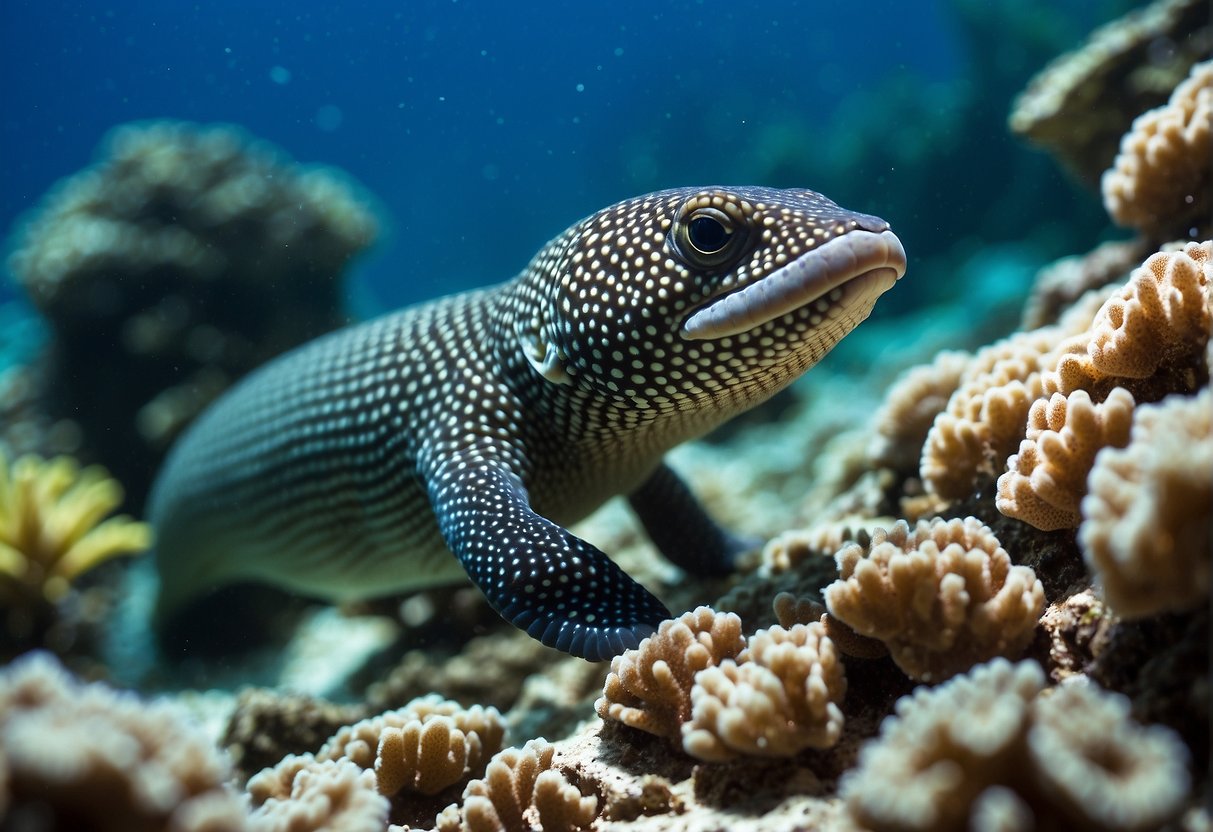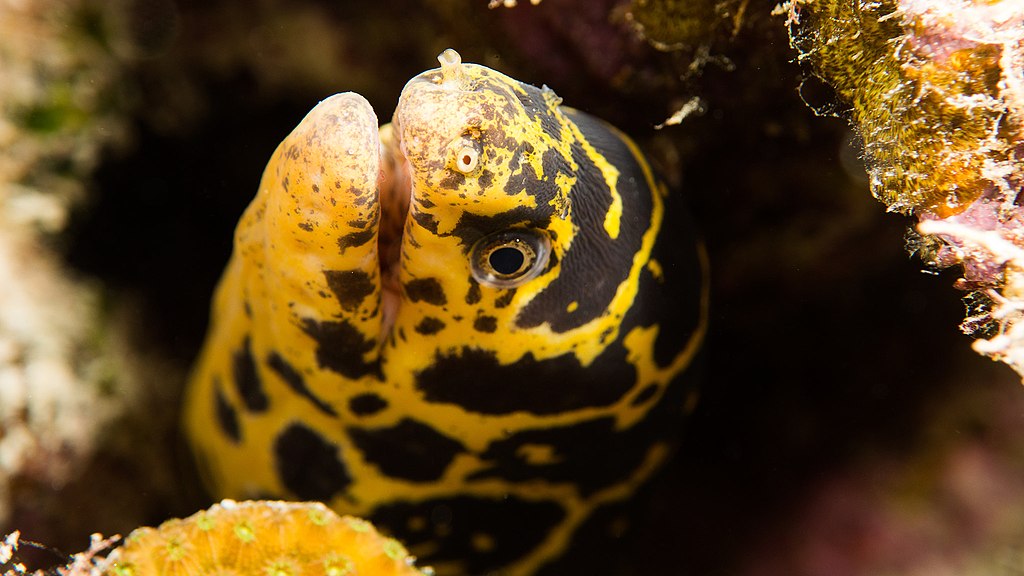The chain link moray eel, scientifically known as Echidna catenata, is a unique and captivating moray eel found primarily in the shallow regions of the western Atlantic Ocean, including nearby islands.
Reaching up to 165 cm (65 inches) in length, these eels are easily identifiable by their distinct chain-like pattern across their elongated, snake-like bodies, making them a popular choice among marine hobbyists and aquarium enthusiasts.

While their colors and patterns may vary from white to yellow with contrasting brown, black, or gray chain markings, the chain link moray eel’s appearance remains striking and easily distinguishable from other eel species.
These fascinating creatures spend most of their days hiding in crevices within coral reefs and rock formations, emerging at night to search for food. When kept in captivity, providing them with ample hiding spaces and mimicking their natural habitat in a 125-gallon or more giant aquarium is essential.
In their natural environment, chain-link moray eels contribute to the ocean’s biodiversity, playing a role in the delicate balance of marine ecosystems.
Understanding Moray Eels

Family Muraenidae
Moray eels are a diverse group of elongated fish belonging to the family Muraenidae, which is part of the order Anguilliformes. Over 200 distinct species of moray eels are found in marine and freshwater environments across the globe. Known for their distinct features like massive heads, pharyngeal jaws, and striking coloration, the moray eel family consists of fascinating creatures.
One exciting species of moray eel is the chain moray eel or Echidna catenata. This eel-like fish usually grows to about 30 to 45 cm (12 to 18 in) and has a rounded snout with pointed, blunt teeth, particularly on the roof of its mouth1. The teeth are used to crush the shells of crabs, their primary food source1.
Scientific Classification
The following table displays the scientific classification of the moray eel:
| Kingdom | Phylum | Class | Order | Family |
|---|---|---|---|---|
| Animalia | Chordata | Actinopterygii | Anguilliformes | Muraenidae |
The kingdom Animalia encompasses all animals, while the phylum Chordata includes animals with a notochord (a flexible rod that supports the structure). The class Actinopterygii pertains to ray-finned fish, the order Anguilliformes consists of eel-like fish, and finally, the Muraenidae family comprises the moray eels.
Moray eels exhibit remarkable diversity in size, color, and habitat, ranging from small species like the chain moray eel to large species like the green moray eel. These fascinating fish can be found in various settings worldwide, inhabiting diverse aquatic ecosystems and displaying unique adaptations to their surroundings.
Anatomy and Appearance
The chain moray eel (Echidna catenata) is a fascinating marine fish recognized for its distinctive features and adaptations.
Exceptional Teeth
One of the most notable aspects of this eel’s anatomy is its unique dental structure. The chain moray eel’s head comprises a rounded snout and an array of pointed, blunt teeth, particularly on the roof of the mouth.
These teeth are designed to crush the shells of crabs, their primary food source 1. In addition to the main teeth, chain moray eels have pharyngeal jaws. These jaws are highly specialized and enable the eel to swallow large prey items whole.
Unique Color Patterns
The chain moray eel is known for its distinctive color patterns. It typically has a background color that ranges from light brown to dark green or black, adorned with a series of lighter, chain-like markings along its body2. This unique coloration is an effective form of camouflage, allowing the eel to blend seamlessly into its surrounding environment.
The overall body of the chain moray eel is elongated and eel-like. It commonly reaches lengths of about 30 to 45 centimeters (12 to 18 inches)1. The tail, dorsal, anal fins, and pectoral muscles are responsible for the eel’s swimming power, with the absence of traditional pelvic fins creating a smooth, serpentine body shape. The muscles on either side of the bodywork harmoniously to produce agile, sinuous movements, facilitating stealthy navigation within its habitat.
A noteworthy feature of the chain moray eel is its body slime. This mucus secretion helps the eel by providing a protective layer against parasites and disease. It also plays a crucial role in reducing friction while swimming, allowing the eel to move efficiently through the water3.
Chain Link Moray Eel Habitat
Geographic Distribution
The Chain Link Moray Eel, or Echidna catenata, can be found in the Western Atlantic Ocean, extending from Florida in the United States to Brazil. These eels have a wide distribution across this region but are predominantly found in the tropical and subtropical areas of the Atlantic Ocean source.
Natural Habitats
These eels are primarily marine species, dwelling in coral reefs and rocky environments. Their preferred depths vary, but they can usually be found in shallow waters to depths of about 40-50 meters (131-164 feet). Chain Link Moray Eels are known to inhabit tide pools and crevices in reefs, where they can easily hide and ambush their prey.
One notable characteristic of the Chain Link Moray’s habitat is its preference for environments with plenty of cover. They utilize this cover to stay hidden and effectively hunt their prey, mainly consisting of crabs and other crustaceans. The eel’s elongated, snake-like body allows it to navigate through narrow spaces within the reef or rock structure, making it a nimble and efficient predator.
Behavior and Temperament
Feeding Habits
Chainlink Moray Eel (Echidna catenata) has a semi-aggressive temperament, meaning it doesn’t typically display aggressive behavior but can become territorial under certain conditions. Its diet mainly consists of crustaceans such as crabs, which they can easily catch with their specially adapted, pointed, blunt teeth designed to crush the shells of their prey source. The feeding process of the Chainlink Moray Eel can be outlined like this:
- Searching for prey: They roam the reef crevices and rocky areas to find crustaceans.
- Capturing prey: Once they spot their prey, they approach them stealthily and grab them with their strong, crushing teeth.
- Consuming prey: After capturing the prey, they usually eat it whole after breaking its shell.
Nighttime Activities
Chainlink Moray Eels are generally nocturnal creatures, which means they are more active during the night. During the day, they prefer hiding in reef crevices and other tight spaces, thus reducing their visibility to other marine animals, including humans.
Some interesting nighttime behaviors include:
- Knotting: The Chainlink Moray Eel has a unique habit of knotting itself in a loop, usually during hunting or when it needs to anchor itself to a specific location. This behavior may serve to provide extra stability and leverage when capturing prey
- Escape Artists: Chainlink Moray Eels are known to be excellent escape artists, as they have been observed slithering in and out of tight spaces with ease, using their long, flexible bodies to maneuver around obstacles or when being pursued by potential predators.
Aquarium Care
Tank Requirements
The Chainlink Moray Eel, also known as the Chain Eel, grows up to a little over 2 feet in length, so it requires a spacious marine aquarium. A tank size of at least 100 gallons is recommended for this eel. Make sure to provide plenty of hiding spots using live rocks and caves, as they are known to be reclusive.
Water Conditions
Chainlink Moray Eels thrive in a stable marine environment. The ideal water temperature for their aquariums should be between 72°F and 78°F. The specific gravity (salinity) should be maintained between 1.020 and 1.025, while the pH level should range from 8.1 to 8.4.
Maintaining good water quality is crucial for the eel’s health. Employ a high-quality filtration system to handle the bioload, as eels can produce significant waste. Regular water changes are recommended, with frequent testing to ensure proper water conditions.
Compatible Tank Mates
These eels are known to be relatively peaceful with other tank mates, making them suitable for a community marine aquarium. However, it’s essential to note that they have a penchant for feeding on crustaceans. So, avoiding adding small invertebrates like crabs and shrimp to their tank is best.
Chainlink Moray Eels can coexist with similar-sized fish without issues, such as large angelfish, pufferfish, and tangs, as they are less likely to pose a threat or compete with the eel for resources. Refrain from adding small fish, which might become unintended meals for the eel.
Taking proper care of a Chainlink Moray Eel involves providing them with an adequate tank size, maintaining optimal water conditions, and selecting compatible tank mates. By following these guidelines, you can ensure a healthy and thriving environment for your eel to flourish.
Dietary Needs
Preferred Foods
The diet of a chain link moray eel mainly consists of various crustaceans, such as crabs, shrimps, and other invertebrates. These eels strongly prefer hard-shelled organisms, which is evident from their specialized teeth designed to crush through the shells of their prey, especially crabs. In addition to crustaceans, they may occasionally consume worms and other small marine animals.
Feeding Practices
Regarding feeding practices, chain-link moray eels are known for their strategic hunting skills. They utilize a technique called ‘sit-and-wait’ predation, wherein they patiently wait for their prey to venture close to their hiding spot before lunging out to catch it. This method allows them to conserve energy and remain inconspicuous to potential prey.
In a captive setting, it is crucial to mimic their natural diet as closely as possible to ensure their health and well-being. Here are some guidelines for feeding chain link moray eels in captivity:
- Live foods: Providing live foods, such as small crabs and shrimps, is ideal as it closely resembles their natural feeding habits and encourages them to exhibit their innate hunting behavior.
- Variety: Introduce a variety of crustaceans and invertebrates to their diet to ensure they receive all necessary nutrients and to avoid potential boredom or pickiness.
- Feeding frequency: Feed them every 2-3 days, as overfeeding can lead to obesity and other health issues.
- Size considerations: Ensure that the food offered is appropriate for the eel, especially when considering its mouth and teeth structure.
Chain Link Moray in Captivity
Aquarium Trade
Due to its striking appearance, the Chain Link Moray Eel (Echidna catenata) is a popular choice for many hobbyists in the home aquarium trade. This species belongs to the same family as the well-known Snowflake Moray and Zebra Moray Eels. Intermediate aquarists, with appropriate-sized tanks, can successfully keep the Chain Link Moray Eel since its long-term survivability depends on live foods and proper care 1(https://animal-world.com/chainlink/).
When setting up a tank for these eels, it is essential to provide:
- A minimum aquarium size of 30 US gallons (114 liters) 3(https://www.livingreefs.com/threads/chainlink-moray.17773/)
- Hiding spots and crevices for the eel to feel secure
- Suitable water parameters and temperature for a healthy environment
Breeding and Lifespan
Although Chain Link Moray Eels are interesting to observe, little is known about their breeding habits in captivity. Breeding Chain Link Morays in a home aquarium has not been documented yet, and research is fairly limited.
In the wild, many moray eel species, like the Snowflake Moray Eel, lay eggs in aquatic habitats, allowing their larvae to develop in the water column before settling into their adult form ^3^. Chain Link Morays may follow a similar reproductive pattern, but further research is required to confirm this.
The lifespan of the Chain Link Moray Eel in captivity is not well documented.
Conclusion
The chain link moray eel, with its striking chain-like pattern and specialized teeth for crushing crustaceans, is a fascinating example of the remarkable adaptations found in marine life. By providing a spacious, meticulously maintained aquarium with plenty of hiding places and a crustacean-rich diet, aquarists can successfully care for these unique eels.
More importantly, the chain link moray eel reminds us why we must protect ocean habitats. Supporting sustainable fishing practices and advocating for coral reef conservation helps ensure that these captivating creatures and the delicate ecosystems they inhabit thrive for generations to come.


